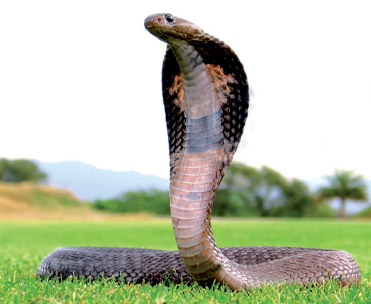 Be careful of the :
Common Cobra!
 Here we produce a Common Cobra
guide to identify Sri Lanka's venomous snakes done in a partnership of
the Wildlife Conservation Society Galle together with the American Red
Cross Disaster Preparedness Program, Sri Lanka Red Cross, World Wildlife
Fund and the Environmental Foundation Limited. Here we produce a Common Cobra
guide to identify Sri Lanka's venomous snakes done in a partnership of
the Wildlife Conservation Society Galle together with the American Red
Cross Disaster Preparedness Program, Sri Lanka Red Cross, World Wildlife
Fund and the Environmental Foundation Limited.
At least 120 deaths are reported annually in Sri Lanka with. Fear,
often caused by the lack of knowledge, leads to the killing of all
snakes as many do not realise that only about 5% of all snake species in
Sri Lanka are venomous. Snakes are a vital factor in maintaining healthy
ecosystems as they prey on disease carrier rodents. The Common Cobra (Naja
naja)
Sinhala: 'Nagata/Naya
Tamil: Nagapambu/Nalla pambu
Description
The only hooded snake found in Sri Lanka having a long, broad
cylindrical body displaying irregular white cross bands. When the hood
is retracted, the neck region appears clearly and broad. The hood bears
a 'spectacle' marking on the dorsal surface (back of the hood)
Behavior
* Mostly active during the day; it is uncommon to encounter cobras
* Commonly found in the vicinity of water and around populated areas
* When alarmed, it lifts about 1/3rd of its fore body off the ground,
spreads its hood and prepared to strike
* A grown cobra will reach lengths of about 100-150cm (upto 3-5 feet)
Venom
* The venom contains neurotoxic (affects the nervous system) and
cytotoxic properties (affects body cells) Symptoms at bite site
* Swelling and extreme pain
* Tissue necrosis (skin cells) are destroyed and skin cna turn black
Symptoms of envenoming (venom entering the body)
* Blurred sight, double vision
* Drooping eyelids
* Difficulty in breathing
What to do in case of a snake bite
1. Reassure the victim and calm the victim down. Un-necessary panic
will only raise the pulse rate and blood pressure and moves the venom
into the system faster. Tell the victim that 70% of snakebites are from
non-poisonous species. Of the remaining 30%, only half will actually
involve injecting venom.
 2. Immobilise the bitten limb without compression. If the bite is on
a hand or arm place it in a sling bandage or use a piece of cloth to
support the arm. In the case of a leg bite, use a splint to support both
legs and bandage them together. Do not tie the bandages tightly. 2. Immobilise the bitten limb without compression. If the bite is on
a hand or arm place it in a sling bandage or use a piece of cloth to
support the arm. In the case of a leg bite, use a splint to support both
legs and bandage them together. Do not tie the bandages tightly.
3. Get the patient to Hospital as fast as safely possible. The best
toxicology unit in the country is at the Peradeniya Teaching Hospital.
Science has shown that traditional remedies do not work so keep the
patient as immobile as possible.
4. Tell the Doctor about any suspicious signs and symptoms of the
patient.
|

